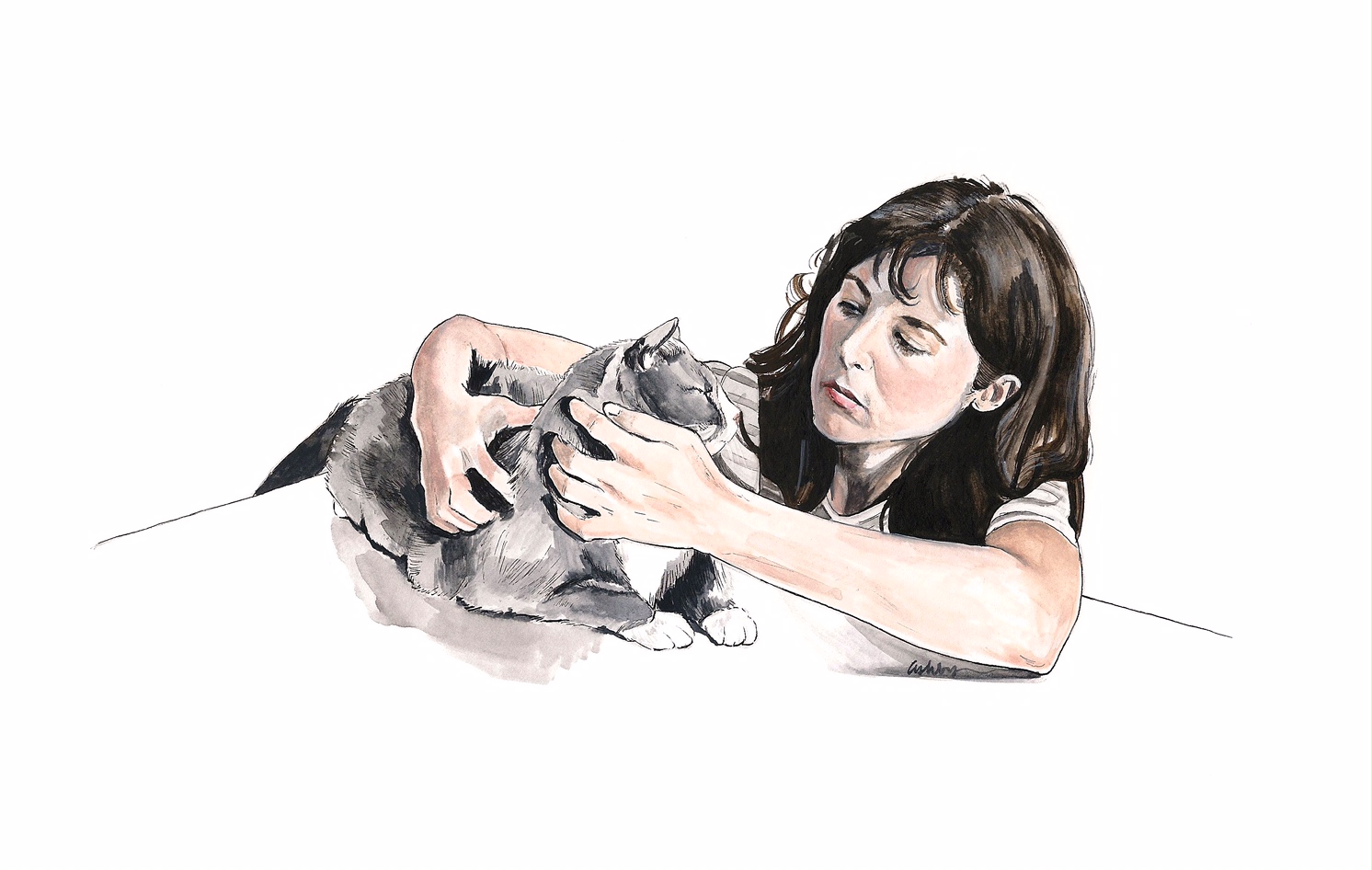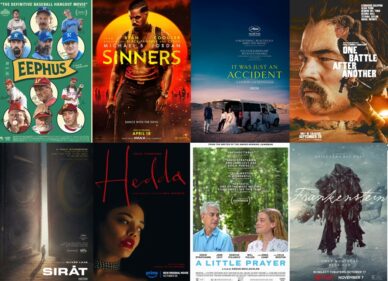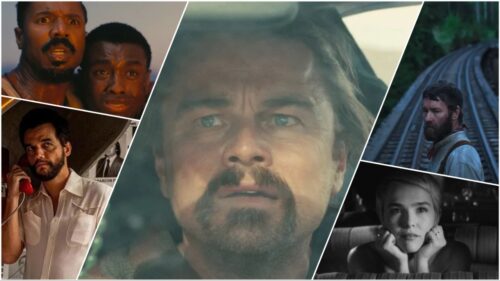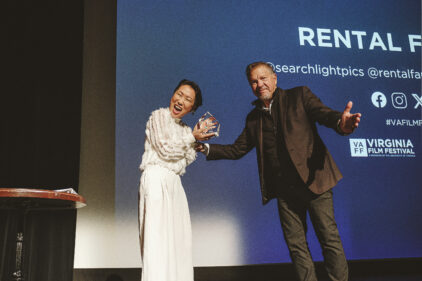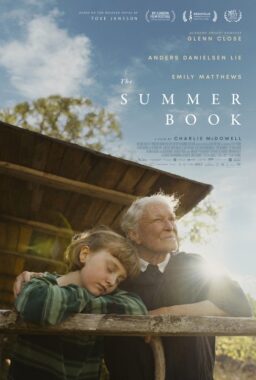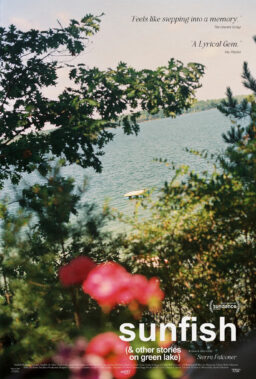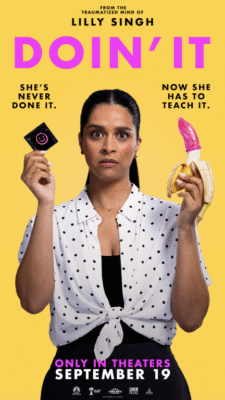We are pleased to feature an excerpt from the September 2016 edition of the online magazine Bright Wall/Dark Room, which is entitled “Friends and Enemies.” In addition to the essay below by Elisabeth Geier on Nicole Holofcencer’s “Walking and Talking,” there are also pieces on “Thelma & Louise,” “Heavenly Creatures,” “A League of Their Own,” “Stand by Me,” “Old Joy,” “Reprise” and “Hell or High Water.” The illustration above is by Brianna Ashby.
You can read previous excerpts from the magazine here. To subscribe to Bright Wall/Dark Room, or purchase a copy of their current issue, go here.
“Walking and Talking” was released 20 years
ago this summer, six years after it was written, making the film around the
same age as its protagonists. It’s tempting to joke about the awkwardness of
being in one’s mid-to-late-twenties and still figuring out your identity, but
the thing about “Walking and Talking”—and every
film from writer/director Nicole Holofcener—is
that it knows exactly who it is. The characters may cast about for purpose,
connection, a clue, but the film itself is deft and direct, like that one
friend you can always count on to plainly tell you the truth.
The night I rewatch “Walking and Talking” for
the umpteenth time, I call my friend M to make plans to hang out. She had
emailed me earlier in the week to propose a weekend getaway, some
“uninterrupted friendship rekindling.” M and I met in grad school in Montana,
two California city girls pursuing vanity degrees in (what felt to us like) a
rural western town. For two years, we were together all the time: movie nights,
road trips, a royal wedding-themed thesis reading complete with commemorative
plates. A classmate once said, “It’s cute how you two are each other’s
boyfriends.” Then we graduated and lived in separate states for a while, and
though we’re in the same city now, of course, things have changed. I’ve
shrugged my way through several jobs and basement apartments; M has
launched a career and bought a house. I fell in love for the first time and
then got my heart broken right around the time M entered a serious
relationship. We see each other often, but lately, something is off. On the
phone, M says, “Not that anything necessarily needs rekindling, but… .” Maybe it does.
Amelia (Catherine
Keener) and Laura (Anne Heche), the best friends in “Walking and Talking,” are in a similar lull. They grew up
together, were at one point roommates and co-cat moms, but now Laura is engaged
(“grotesquely in love,” as Amelia tells her therapist), Amelia and the cat live
alone, and the two women struggle to be there for one another while dealing
with their own lives, all the while ramping up towards Laura’s wedding. Laura
has work woes—she’s a newly-credentialed therapist who worries she’s terrible
at her job—and pre-wedding doubts; she flirts with a waiter and freaks out
about a mole on her fiance’s chest. Amelia has boy problems; she has an awkward
fling with the clerk at her video store who she and Laura call Ugly Guy (Kevin Corrigan),
and she keeps loaning her ex-boyfriend money. They both feel like they’re
drifting away from their best friend.
Holofcener gives both
women complete, complex attention, but to me, “Walking and
Talking” is Amelia’s
film. The camera tags along through her life as she works at the newspaper
classifieds desk, rents movies, washes dishes, and leaves rambling answering
machine messages for her friend. In his 1996 review, Roger Ebert
described Amelia as, “A person of reasonable intelligence who stands on the
sidelines and watches the sweethearts on parade.” Hi, this is me, meekly
raising my hand.
As I told M while
clumsily asking permission to write about our friendship as it relates to “Walking and Talking,” “I expected to have grown out of
this by now.” In fact, I feel more Amelia than ever. I’ve been through a major
social restructuring in the past year. My long-term, live-in relationship
ended; one of my closest friends fell in love and moved across the country;
other friends (M included) are in the midst of personal and professional
successes that seem to leave less and less time for me. Like Amelia, I find
myself spending a lot of weekends watching movies alone.
In the wake of so much
change, and the threat of complete isolation, I’ve tried to expand my social
circle. I started “putting myself out there,” joining MeetUp.com groups,
introducing myself to women at the gym. My therapist calls this “planting
seeds,” and says I just have to be patient while I wait for my garden to grow.
(My therapist also says she’s proud of me, but I’m paying her, so who knows.) I
do my best, but tend to overwater the seeds I’m most excited about; divulging
too many intimacies and sending too many exclamation-pointed texts until they
retreat into the ground. Or I get overwhelmed by the energy it takes to tend a
new friendship, retreat completely, and watch them dry out. Or I write stupid
gardening metaphors to avoid plainly telling the truth, which is that I’m
lonely and I need a full-grown friendship, and all this planting, watering, and
waiting sucks.
There’s no rushing the kind of intimacy Amelia and Laura have.
They borrow each other’s clothes. They order for each other at restaurants.
Several times throughout the film, they just show up at each other’s doors. No
phone call, no warning, sometimes not even a knock. How many people can you do
that with? Being honest, I can count two, and both of them would think it was
an emergency rather than a good old-fashioned swinging-by.
In one scene, Amelia
swings by really needing to talk, and Laura isn’t home. But her fiancée Frank
(Todd Field) is. The two of them get stoned over a pile of laundry and, while
watching at home, I decide to get stoned too. Recreational pot is legal where I
live, but it still feels illicit sometimes, the way buying a six pack felt when
I was newly 21. I don’t usually keep it in the house, but I bought some from a
dispensary a few months back while en route to a weekend away with friends
because intoxication is a time-honored bonding activity, even for grown-ups in
their thirties. It certainly bonds Amelia and Frank. Neither one of them knows
where Laura is, and it’s unusual for them to be alone together, but pot seems
to put them at ease. They talk about Frank’s work designing jewelry; Amelia
concedes she hasn’t shown much interest in it before, and he seems genuinely
excited to tell her about it. Of course, the conversation turns to Laura. She’s
the main thing they have in common.
Silly and stoned,
holding one of Laura’s socks, Frank says, “Isn’t this the teeniest, tiniest,
most adorable thing you’ve ever seen?”
“She wears an eight,”
Amelia tells him as if she’s breaking bad news. She seems baffled and amused by
his mooniness. Of all the things to love about Laura, a gym sock?
This scene between
Amelia and Frank is a quick three and a half minutes in the middle of the film,
but it captures the sometimes-awkward dynamic between best friend and best
friend’s lover. They both love the same woman, but Amelia has loved her longer,
and she’s protective of that fact. She likes Frank, but she’s jealous. She
laughs at him because in this moment, her own feelings towards Laura are more
complex than an adorable sock. Or maybe she only laughs because she’s stoned.
Maybe this is me, projecting.
In a later scene, in
the midst of her complicated reaction to Laura’s engagement, and her own
troubled dating life, Amelia asks her ex-boyfriend Andrew (Liev Schreiber), now
her close friend, why they broke up. After dodging the question a few times, he
finally, reluctantly tells her: “You made me too important…like I was
everything.” Amelia doesn’t say it out loud, but the look on Keener’s face is
enough: Isn’t that the
point?
Like Amelia, I
sometimes struggle with feelings of jealousy and rejection when it feels like
my life has stalled and everyone around me is moving forward. It’s hard to feel
like you’re suddenly on the outskirts of a friend’s life when you used to share
the center. Usually, I can get over myself and handle a weekend alone. But on
this particular night, I am edgy and stoned and staring at my dogs who
sometimes seem like the only creatures that will ever love me the way I need to
be loved: silently, out of dependence and until they die.
Keener was 36 when “Walking and Talking” began
shooting, which makes me feel a lot better for how intensely I identify with
her character today. Holofcener never makes clear exactly how old Amelia and
Laura are supposed to be, but Amelia embodies a certain thirty-somethingness:
she’s unsettled, but comfortable in her skin. She has a career, an apartment,
and good friends, but is still trying to figure out who she is. She’s a
grown-ass woman, but that doesn’t mean she’s not lonely, selfish, and
vulnerable sometimes. Holofcener was around 30 herself when she started writing
the film, and 35 when it finally got made, so it’s no surprise she gets it so
right. As a woman in my mid-thirties now, it’s incredibly gratifying to see
that experience, and that vulnerability, reflected on film. In fact, I can’t
think of another movie that reflects it so completely and so well.
Ina 2011 column for IndieWire,
Holofcener recalls film executives initially turning down the script for “Walking and Talking” because
it was too “soft.”
“I thought that was
bullshit,” Holofcener writes, “but at the same time I didn’t fight what they
said was ‘soft’ about it—that there was no big hook and that it was about
women. (It’s funny, because it has the same hook as “Bridesmaids“: Single girl’s best friend gets married and
her life falls apart.)”
When I was thinking
about my favorite movies about women, movies that reflect the important
friendships in my own life, “Bridesmaids” was near the top of the list. I love
the performances, the jokes, and the scene where Kristen Wiig and Maya Rudolph
have their come-to-Jesus talk in the bathtub. But what “Bridesmaids” does
so well, “Walking and Talking” did first,
more realistically, and for a lot less money.
Life doesn’t always
have big hooks. More often, it just sort of happens, and that’s what I
appreciate about the lives portrayed in Holofcener’s films. I had an improv
coach who used to say that a good scene was almost always either “another day
at the Joneses, or the day the shit hits the fan at the Joneses.” Holofcener’s
specialty is doing both at once: showing the quotidian lives of her characters
(in an early scene, Amelia sniffs a cantaloupe at a bodega; in a later scene,
she throws away the rinds) while also showing the shit (Andrew’s dad has
Alzheimer’s; Frank and Laura almost break up; Amelia and Laura argue over
whether or not to pay for chemotherapy for the 14-year-old cat they once
shared).
“It’s episodic,” my friend “S” texted after watching “Walking and Talking” at
my urging (funny thing about this film: you will immediately want all of your
closest friends to see it). I hadn’t thought of it that way, but it’s apt.
Holofcener uses short scenes and soft edits to mirror how time passes in real
life. One thing happens, and then another, and tension builds, but there’s not
a big, obvious arc. Amelia and Laura are in crisis, individually and as a pair,
but crisis doesn’t have to be an explosion. Sometimes, it’s an unanswered
phone.
It takes Amelia and Laura most of the film to directly address the growing
tension between them. Another of Holofcener’s specialties is writing
confrontations between people who love one another, and the scene where Amelia
and Laura actually say what they mean is some of her finest work. They have
their come-to-Jesus talk when Laura shows up at Amelia’s door after a disastrous
pre-wedding hair and makeup appointment. Amelia washes Laura’s hair in the
kitchen sink, and while she’s combing out the tangles, things finally come to a
head.
“You used to need
me,” Amelia says. “When something happens to me now, good or bad, I tell you.
When something good or bad happens to you, you tell Frank. It feels unfair.”
After ninety minutes
of watching Amelia and Laura struggle to communicate, it’s such a relief to
hear her say these words out loud (maybe because I haven’t said them myself, at
least not to the people they’re about). Laura’s response is sympathetic and
defensive all at once.
“Nothing I do is ever
enough for you,” she says. “It’s like when Frank and I got engaged, you decided
that I don’t care about you anymore, and that is just not true.”
In the classic form
of someone being told an uncomfortable truth about themselves, Amelia doubles
down on her accusation: “You’re so wrapped up in what’s happening to you that
you don’t even know what I’m going through. Stop for a second and think of what
it’s like for me.”
“What is it like for
you?” Laura asks.
“Hard,” Amelia says.
“Sad. I miss you.” Then, she catches herself (Keener’s face in this moment is
everything), and realizes she should be asking, too: “What’s it like for you?”
“It’s lonely.”
My friend “J”
recently tweeted, “Life became more gentle and less judgmental when I began to
think of the people in it as the narrators of their own memoirs.” This has
become a useful rubric for me in my own think-of-what-it’s-like-for-me moments.
We’re all telling our own stories; the more intimate the relationship, the more
two stories may overlap, but each narrator will tell it in a different way.
In Amelia’s story,
her best friend has abandoned her for a man; the men in her own life have
rejected her for reasons she doesn’t understand; she is aimless and lonely; and
then her cat dies (spoiler, sorry). In my story, I got dumped, my best friend
fell in love, my other best friend also fell in love and moved across the
country, and it often feels like the people I want to be closer with are too
busy to make time for me. But part of being a grown-ass woman is recognizing
other people’s narratives, and gently reminding them to recognize yours.
I worry that in
talking about why “Walking and Talking” is so important
to me, I haven’t said enough about why it might matter to anyone else, and I
want people (not just my friends) to watch it. So: “Walking and Talking” is
funny. Holofcener’s dialogue is hilarious, true-to-life, and exposes her
characters’ smart, messy, selfish humanity. Keener and Heche are brilliant and
beautiful, just like your real-life best friends. The side characters are
endearing and real in a way that makes it clear they have their own stories to
tell (as much as I love Amelia, and a film about women, if the camera shifted
to follow Andrew or the Ugly Guy, the resulting film would probably be just as
good). At one point, Schreiber does muscleman poses in tight leather pants.
Trust me, it’s good.
Most of all, “Walking and Talking” is
the kind of movie that makes you immediately text a friend, maybe a friend you
recently lost to a cross-country move, whose everyday presence in your life you
took for granted until she was gone. A friend whose life-changing romantic
relationship came with so much joy, along with a healthy side of “it feels
unfair.” A friend you haven’t talked to much in the months since she’s been
gone because you don’t feel needed anymore.
As soon as the movie
ended, I texted my friend “L” all the way in Massachusetts: “I just rewatched “Walking and Talking” and
it made me think of you [yellow heart emoji].”
“If I hadn’t already
removed all moisture from my body today via crying, this would make me cry,”
she wrote back. “I’ve been feeling so un-missed.”
I’ve been so busy
wallowing in my own loneliness, getting stoned and sad and watching movies with
my dogs, I’ve sometimes neglected to consider the narratives of the people I
love. I’ve made some selfish assumptions, and avoided saying the simple things
that need to be said.
When Amelia and Laura finally acknowledge each other’s
experiences out loud, the tension dissipates almost immediately. Laura is still
getting married, Amelia is still a little lost, and nothing is going to be the
same as it was. But they’re re-committed to experiencing whatever comes next
together. Maybe this is what it means to be a grown-up best friend: to accept
that change is inevitable, and sometimes hard, but we don’t love each other any
less. To mourn the past version of our friendship while nurturing whatever it
looks like today. To do our best to pick up the phone and say the simple things
that need to be said: I miss you. I love you. I’ll always be your friend.
